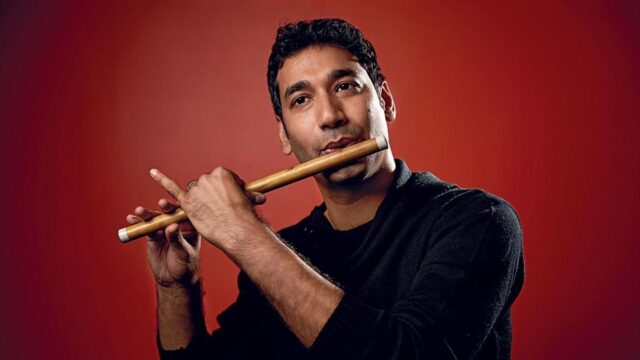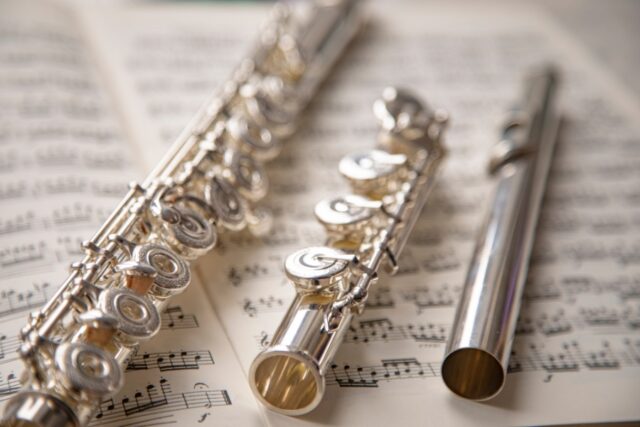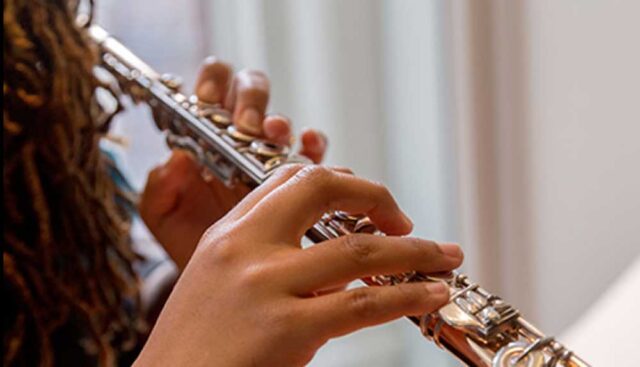
The flute is a magical instrument with an engaging, ethereal tone that is beautiful to hear. In addition, playing the flute carries a number of important health benefits, from improving sleep patterns to increasing the production of cancer-fighting cells. Once you acquire an instrument and some easy flute sheet music, you are ready to learn to play. Here are some suggestions for beginner flute players to help master the instrument and harness its amazing benefits.
Understand the Parts of the Instrument

Before you can master the flute or even attempt easy flute music, you must learn the parts of the instrument, understand their function, and learn hand & finger placement. The flute consists of three sections.
Head Joint
The head joint of the flute is also known as the neckpiece. This is the part of the instrument that generates the sound as the flutist expresses air into it. The head joint includes the lip plate where you place your lips and blow air across the instrument. On top of the lip plate, the head joint also includes:
- The crown: Creates a seal so air can only travel past the keyholes
- Embouchure hole: Allows air from the player to enter into the flute
Middle Joint
Flute keys are padded, round metal covers mounted on the middle joint, also known as the body. Pressing these keys manipulates the airflow, which raises or lowers the instrument’s pitch. The middle joint also includes:
- The barrel: Generally for decorative, branding purposes where the flute’s designer & model information can be found
Foot Joint
The foot joint is the short section of the flute with a small number of keys. This is the part of the instrument that emits sound. There are times when the foot joint has an extra ‘B foot’ key which allows players to go a note lower than regular flutes.
Learn to Assemble the Flute

Proper assembly of your instrument is essential to avoid frustration and keep from damaging the flute. The most critical thing is not to twist the mechanism. When putting the head joint and middle joint together, hold the instrument above or below the lip plate and keys. You should also be sure to align the head joint and foot joint correctly. Beginners are often tempted to push the head joint fully into the body; however, the instrument is designed to be pulled out slightly to keep the flute in tune.
Learn the Proper Hold
The flute is an awkward instrument to hold. Nearly every beginning flute player struggles with holding the instrument as they are first learning to play, but with time and practice, it’ll become second nature.
Left Hand
When playing the flute, your left-hand plays the keys nearest to the mouthpiece. The left thumb should rest on the bottom key on the body of the flute with the other fingers curved around the instrument and resting on the 2nd, 4th, and 5th keys and the pinky finger touching the side key.
Right Hand
Your right hand will hold most of the flute’s weight, supporting the instrument with your right thumb tucked underneath and the right palm facing away from you. Make a C shape with your hand, and rest your index finger, middle finger, and ring finger on the three bottom keys near the foot joint.
Master the Correct Embouchure
Embouchure refers to the shape of your mouth. For playing the flute, you must form a small hole in your mouth and express air through that hole. The proper shape enables you to create quality sound without running out of air too fast.
Practice Appropriate Posture
Whether you are playing the flute from a sitting or standing position, your shoulders should be aligned over your hips. Bring the flute to your lips in a playing position with your head turned 45 degrees. The flute should intersect your left shoulder and the end of the instrument should be aligned with your nose. Your easy flute sheet music should be propped on a music stand at a level that enables you to maintain this position while reading the music.
Be Patient
A common mistake that many beginners make is rushing into the attempt to play full music pieces rather than learning the instrument note by note. You will master the flute faster by learning a note and then adding a new one. When a combination of two notes is comfortable, add another note.
You will learn that some fingerings on the flute are simpler than others, so take them slowly. As you learn the technique and transitions between notes, increase the tempo. Above all, be patient with yourself. You will not master the flute overnight, but the process of learning easy flute sheet music is fun, and tracking your progress can be gratifying.
Practice

The old saying “practice makes perfect” has a lot of merit. While perfection is probably unrealistic, proficiency is an attainable goal. You should practice in short sittings, starting out with 15-20 minutes each day and increasing in duration as your capabilities grow. Set an attainable goal for each practice session to keep yourself encouraged and maintain a sense of daily accomplishment.
Great Songs to Start With
Here are several popular, yet easy songs to get started on as a beginner on the flute. Rushing into intermediate and more difficult pieces will only frustrate newer students on the instrument. These songs are fun to play and good to learn on:
- “Let It Go” – Idina Menzel
- “Swinging on a Star” – Bing Crosby
- “Hot Cross Buns”
- “Yankee Doodle” – Richard Shuckburgh
- “Jingle Bells” – James Lord Pierpont
- “My Heart Will Go On” – Celine Dion
- “Over the Rainbow” – Judy Garland
- “Can’t Help Falling in Love” – Elvis Presley
- “Ode to Joy” – Ludwig van Beethoven
- “What a Wonderful World” – Louis Armstrong
Find Easy Flute Sheet Music
As you are learning your instrument, start with easy flute sheet music that is tailored to beginning musicians. This will enable you to experience success with simple songs. Sites like Musicnotes have a large archive of sheet music for beginners for any and all instruments. Click here for more flute sheet music today!









